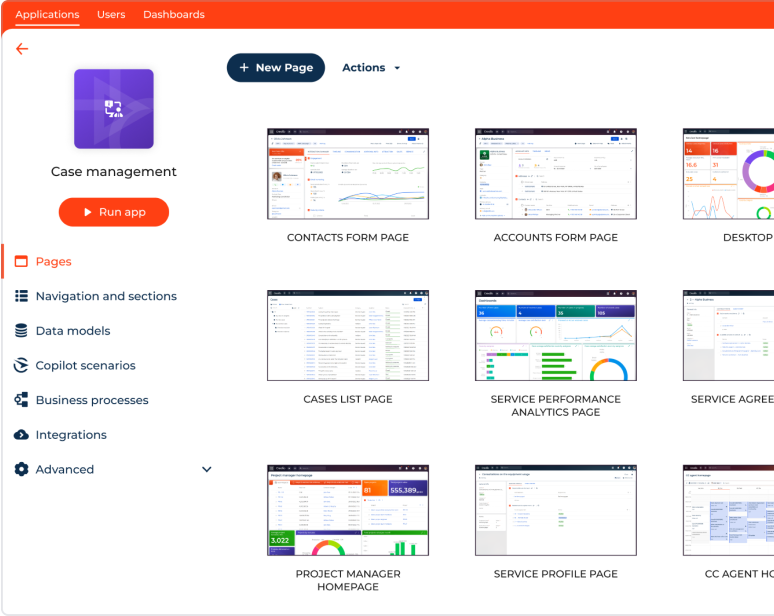-
No-Code
Platform
-
Studio
No-code agentic platform delivering the fastest time-to-value and the highest ROI
-
Studio
-
AI-Native CRM
CRM
-
AI-Native CRM
New era CRM to manage customer & operational workflows
CRM Products -
AI-Native CRM
- Industries
- Customers
- Partners
- About
A Comprehensive Guide to Insurance Automation Software: What Tools to Consider in 2025
Updated on
June 27, 2024
14 min read
Creatio: Enhance Claims to Resolution With AI & No-Code

Did you know that the global insurance technology market is projected to grow more than 28-fold by 2030?
According to Grand View Research, the Insurtech market is expected to reach $152.43 billion by 2030, increasing from $5.45 billion in 2022. This growth is primarily driven by the demand for greater operational efficiency, improved agility, and enhanced customer experience across insurance processes.
Insurers are adopting automation to address long-standing challenges, including manual documentation, fragmented systems, and evolving regulatory requirements. One of the most effective ways to address these is by implementing insurance automation software – solutions designed to streamline tasks, reduce processing time, and manage complex workflows at scale.
In this guide, we’ll explore what insurance automation software is, its benefits and application areas, best implementation practices, and the top tools to consider in 2025.
What is Insurance Automation Software?
Insurance automation software is a digital solution designed to streamline and automate core operations within the insurance industry. These platforms leverage workflow automation, artificial intelligence (AI), robotic process automation (RPA), data analytics, customer relationship management (CRM) systems and other technologies to reduce manual effort and boost operational efficiency.
By automating tasks across the entire insurance lifecycle, including (but not limited to) policy issuance, underwriting, claims processing, billing, and customer service, insurance automation tools help teams accelerate decision-making, reduce operational costs, enhance compliance, and improve overall customer satisfaction.
Why Do You Need Insurance Workflow Automation?
Many insurance companies still rely on manual processes and legacy systems that no longer meet rising customer expectations, operational costs, and regulatory demands. Insurance workflow automation helps organizations modernize operations and address key industry challenges, such as:
- Process delays: Manual tasks slow down various insurance processes such as claims, approvals, and service delivery.
- Resource inefficiency: Staff spend too much time on repetitive tasks and low-value activities.
- Disconnected systems: Data lives in silos, causing errors, delays, and extra work to keep everything aligned.
- Customer service gaps: Policyholders expect timely communication, real-time updates, and self-service capabilities that manual workflows cannot deliver.
- Compliance risks: Regulatory changes are harder to track and implement manually.
- Limited scalability: As business volume grows, manual operations struggle to scale without proportional increases in cost or headcount.
10 Best Insurance Workflows Automation Systems for 2025 and Beyond
Once you start exploring insurance workflow automation, you’ll quickly find plenty of great vendors to choose from. Each platform offers different capabilities, pricing models, and features, making the final decision really challenging.
To help simplify your search, we’ve compiled a list of standout solutions that are gaining traction within the insurance industry in 2025:
Software | Best for | Pricing | G2 Rating |
| Creatio | A comprehensive AI-native solution for insurance workflow automation and CRM | 3 plans, starting from $25 per user/month; Free trial and product demo are available. | 4.6 / 5 |
| Tungsten Automation | Document and workflow automation platform | Pricing is provided upon request; Product demo is available | 4.3 / 5 |
| UiPath | Agentic and robotic workflow automation for enterprises | Pricing is provided upon request; Free trial is available | 4.6 / 5 |
| 360SiteView | Digital claim management system | Pricing is provided upon request; Product demo is available | 4.5 / 5 |
| Aclaimant | Productivity and risk management information system | Pricing is provided upon request; Product demo is available | 4.9 / 5 |
| Salesforce | CRM and insurance-specific workflow capabilities | 4 plans, ranging from $25 to $550+ per user/month | 4.4 / 5 |
| Nintex | Workflow Automation and risk management platform | Pricing is provided upon request; Product demo is available | 4.2 / 5 |
| Kissflow | Case management and workflow automation | 2 plans, starting at $1,500 per month; The trial is provided upon request | 4.4 / 5 |
| Guidewire ClaimCenter | Claim management system for P&C insurers | Pricing is provided upon request; Product demo is available | 4.5 / 5 |
| Britecore | Insurance platform for advanced analytics and reporting | Pricing is provided upon request; Product demo is available | 4.3 / 5 |
* Pricing plans last updated in June 2025
1. Creatio
Creatio is an all-in-one platform to automate insurance workflows and CRM with AI, no code and a maximum degree of freedom. It allows insurance companies to optimize a range of processes related to claims and policy lifecycle and build customer-centric experiences at scale. With no-code capabilities and composable architecture, Creatio enables teams to improve specific processes, build unique workflows, and integrate with other systems in the insurance tech stack without IT involvement.

Creatio offers a variety of out-of-the-box capabilities to automate sales, marketing, and customer service, including claim management automation, policy administration, and underwriting for insurance organizations. This enables insurers to automate sales processes, build targeted marketing campaigns, manage leads, track customer interactions, and deliver high-level support to policyholders. As a result, insurance companies can enhance engagement, improve conversion rates, and boost client loyalty.
With access to over 700 third-party applications and pre-built integrations and connectors, the platform’s functionality can be further extended to fit the unique needs of any insurance organization.

Creatio is a robust solution for medium to large companies seeking an adaptable, efficient, cost-effective workflow automation software with unified architecture. According to the recent study by Nucleus Research, businesses using Creatio have achieved a 61% reduction in lead response time and a 17% drop in manual data entry, which again underlines its quality and performance.
See how Saskatchewan Blue Cross fully transformed their business processes and increased employee performance by 25% with Creatio’s no-code technology.
Core features:
- Sales: Boost agent productivity with AI-powered lead scoring and a unified workspace to streamline lead management and sales workflows.
- Marketing: Empower your marketing team with advanced tools for segmentation, campaign automation, and loyalty program management to drive engagement and retention.
- Onboarding automation: Simplify the customer onboarding process with efficient KYC processes and omnichannel support.
- Underwriting and verification: Gain a comprehensive view of customer data, streamline underwriting with automated checklists and content development, and ensure transparent, auditable document management.
- Claims processing: Keep track, and accelerate the entire claims lifecycle, from intake and investigation to appraisal, resolution, and reporting..
- Policy administration: Effectively manage policy creation, updates, renewals, and compliance with end-to-end process automation.
- No-code customization and configuration: Tailor your business processes effortlessly, promoting flexibility and adaptability in the rapidly changing industry.
- AI-native capabilities: Enhance insurance processes with AI-powered tools to personalize client interactions, uncover actionable insights, forecast future trends, and automate repetitive tasks and workflows with ease.
Pricing:
Creatio offers a composable pricing model in which companies pay only for the products they need.
The core platform offers three plans: Growth ($25), Enterprise ($55), and Unlimited ($85) per user per month, with the core AI capabilities (Predictive AI, Generative AI , and Agentic AI) added at no cost.
A free trial is available, product demo is provided upon request.
2. Tungsten Automation (formerly Kofax)
Tungsten Automation stands out as a comprehensive solution designed to optimize various insurance-related processes with intelligent automation, document management, and process orchestration.
Core features:
- Automated customer onboarding with real-time mobile engagement
- Proactive claims handling with automatic document capture
- Accelerated underwriting through swift data extraction
- Efficient digitization of branch-related policyholder documents
- Streamlined health and injury claims management
- Enhanced customer engagement with personalized communications
Pricing:
The platform’s pricing is provided upon request, product demo is available.
3. UiPath
UiPath is a popular platform that provides enterprises with a comprehensive suite of automation capabilities for enterprise companies. This automation platform is best known for its advanced robotic process automation (RPA) capabilities, helping insurers optimize a wide range of back-office and customer-facing workflows. In particular, UiPath can assist in manual processes that are repetitive, rules-based, and require interaction with multiple systems.
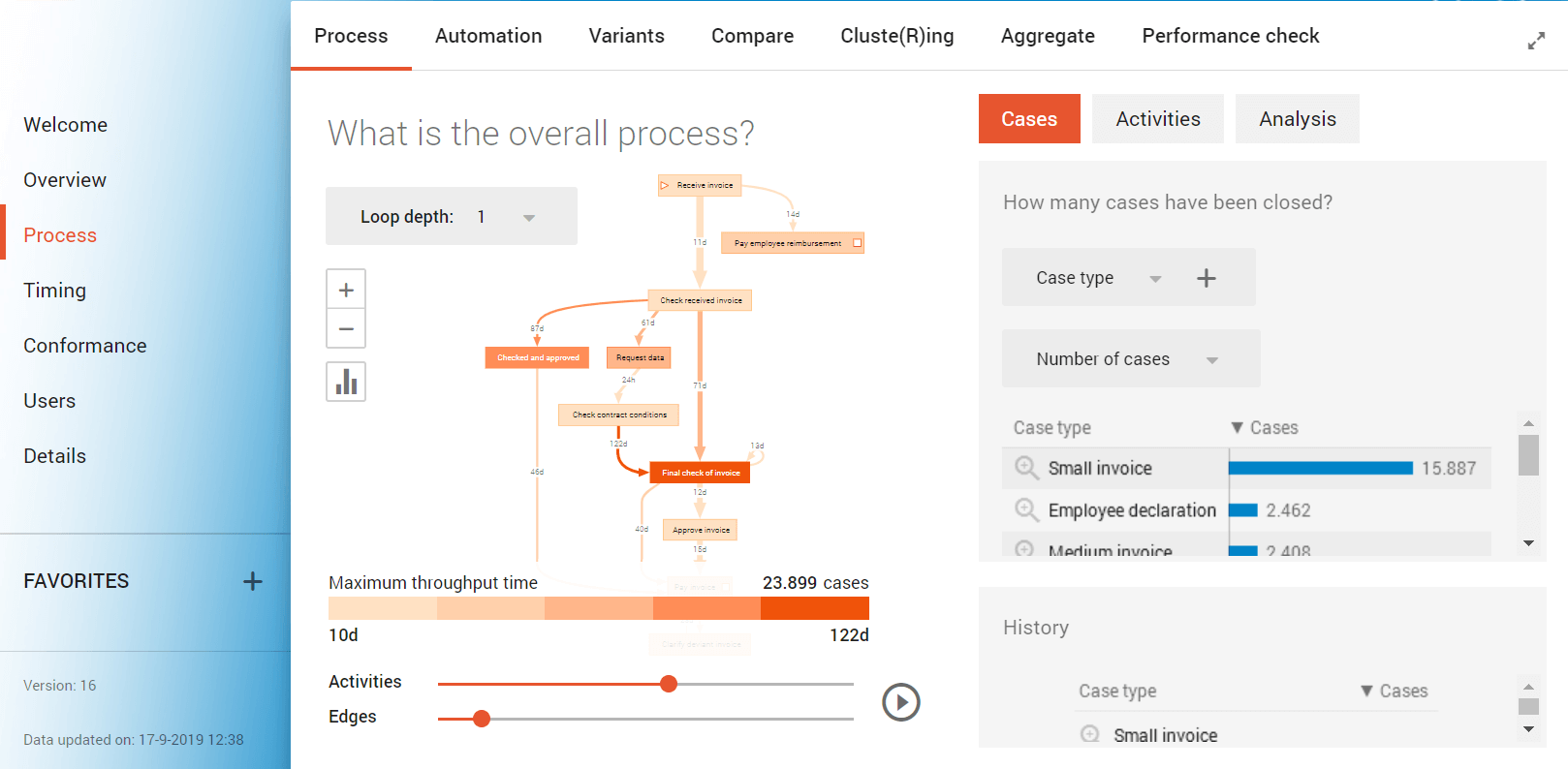
Core features:
- Practical AI integration
- Swift and holistic platform management
- Low-code development tools
- Combined RPA and API integrations
- Intelligent document processing
- Secure deployment of AI and machine learning models
- Versatile robotic capabilities for various tasks
- Enhanced collaborative decision-making between cross-departmental teams
Pricing:
The platform’s pricing is provided upon request, a free trial is available to test the basic functionality.
4. 360SiteView
360SiteView is a specialized workflow automation platform designed to meet the operational needs of insurance agencies and brokerages. It provides a functional solution to streamline client servicing, claims workflows, compliance processes, and internal communication.
Core features:
- Allows customers to report and manage their own interactions, enhancing overall experience and efficiency
- Offers both online and contact center interfaces
- Efficiently categorizes each task or request based on its specifics
- Allows teams to craft and deploy any digital process without technical expertise
- Demonstrates versatility by catering to diverse insurance sectors, from motor to marine, underscoring its broad applicability
- Enhances operational insights by providing real-time data through live video, images, and documents
Pricing:
The platform’s pricing is provided upon request, product demo is available.
5. Aclaimant
Aclaimant is a risk management and safety platform that helps insurance teams automate workflows related to incident reporting, claims tracking, and risk assessment. It allows for digitizing and streamlining processes that are often handled manually or inconsistently, and provides a measurable impact in reducing risk-associated costs.
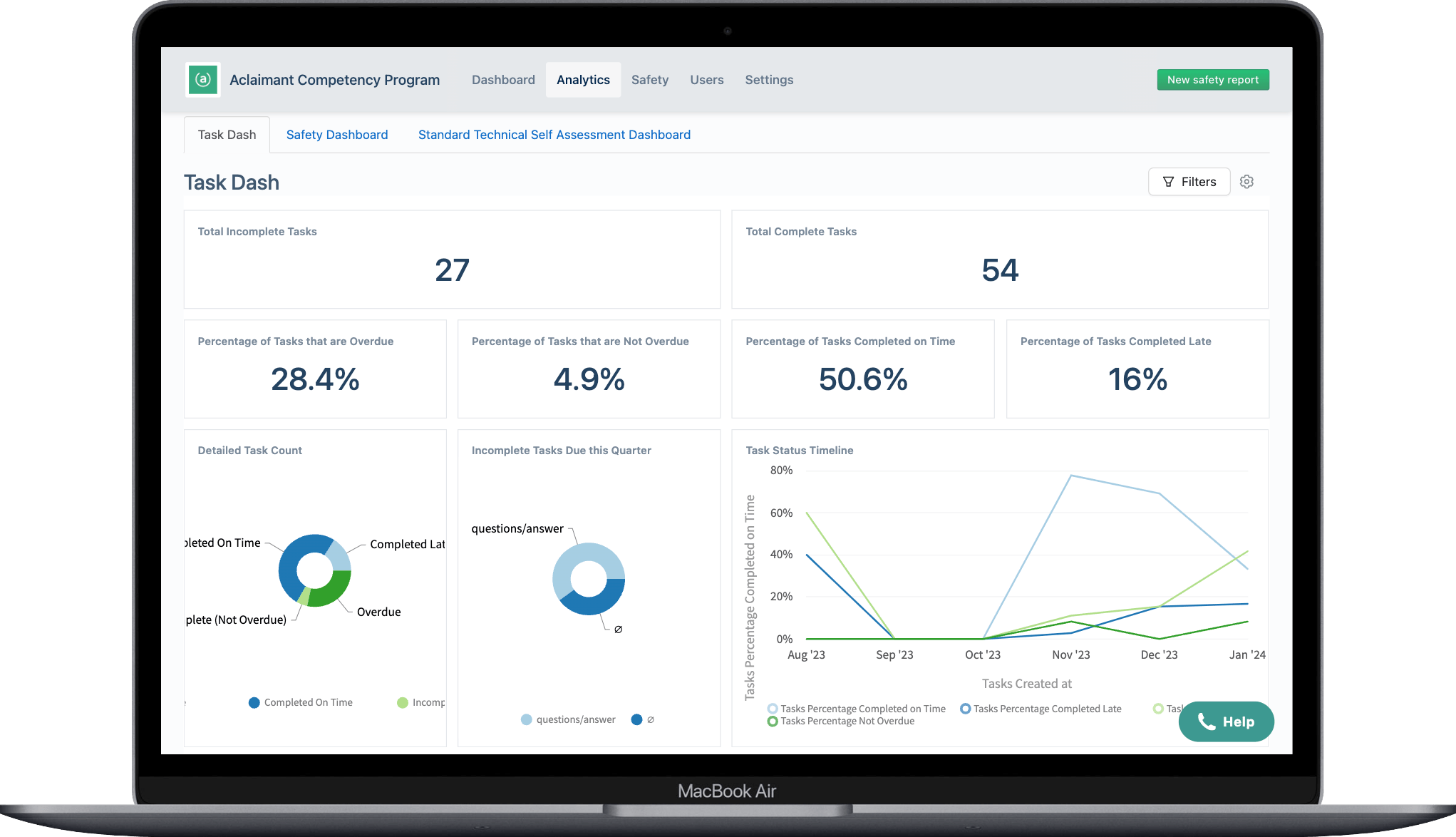
Core features:
- Centralized RMIS for immediate incident-to-office connectivity
- Swift submission of incidents and claims
- Secure and searchable repository for incident and claims forms
- Auto-completed OSHA forms and safety tracking
- Enhanced incident and workflow analytics
Pricing:
The platform’s pricing is provided upon request, product demo is available.
6. Salesforce
Salesforce is a popular market-leading CRM platform that offers extensive workflow automation functionality designed for various industries. While not built exclusively for insurance, it is widely adopted for managing customer relationships, process automation with Flows tool.
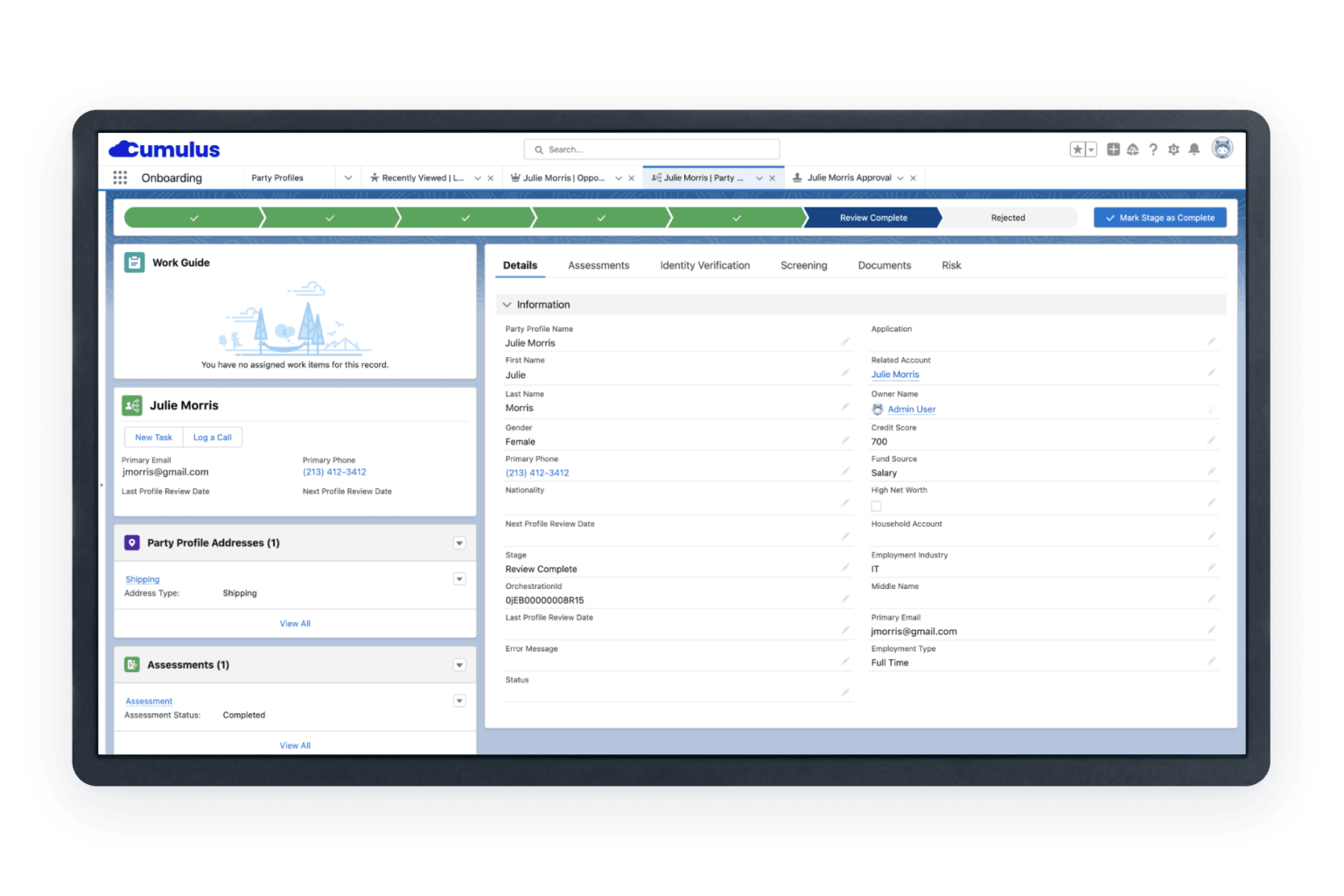
Core features:
- Centralized data collection in one platform
- Custom workflow automation for claims, renewals, underwriting, and service tasks
- Automated messaging, alerts, and self-service options across email, SMS, chat, and portals
- Extensive integration capabilities with third-party apps and core insurance solutions - via APIs or MuleSoft (Salesforce-owned).
- AI-powered insights and predictive analytics through Einstein AI
Pricing:
Salesforce offers multiple pricing plans, ranging from $25 for the Basic CRM functionality to $550+ per user/month for the enterprise-grade plan with AI agent functionality. There is also a Policy Administration product, priced at $75,000 per $5 million GWP.
7. Nintex
Nintex is a powerful process automation platform that enables insurers to design, execute, and optimize digital workflows across operations. While not insurance-specific, Nintex is widely used in the industry to digitize manual tasks, standardize procedures, and improve compliance through low-code automation.
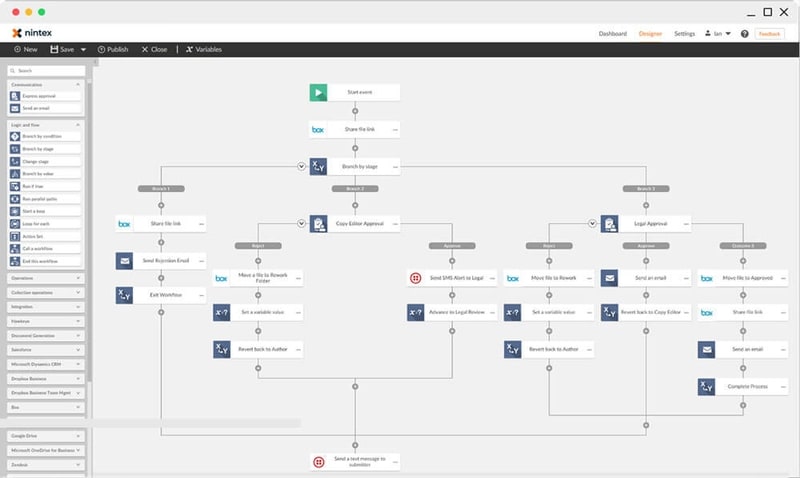
Core features:
- Visual design tools to automate document approvals, claims routing, and underwriting processes
- Process mapping and optimization
- Connectivity with CRM, ERP, policy admin, and content management systems
- Document generation and electronic signatures
- Governance and audit trails
Pricing:
The platform’s pricing is provided upon request, product demo is available.
8. Kissflow
Kissflow is a low-code workflow automation platform that enables insurers to streamline a wide range of case-based and rule-driven processes. It is widely used by operations teams to build custom workflows without writing code, which makes it suitable for mid-sized insurers and agencies seeking agility and control.
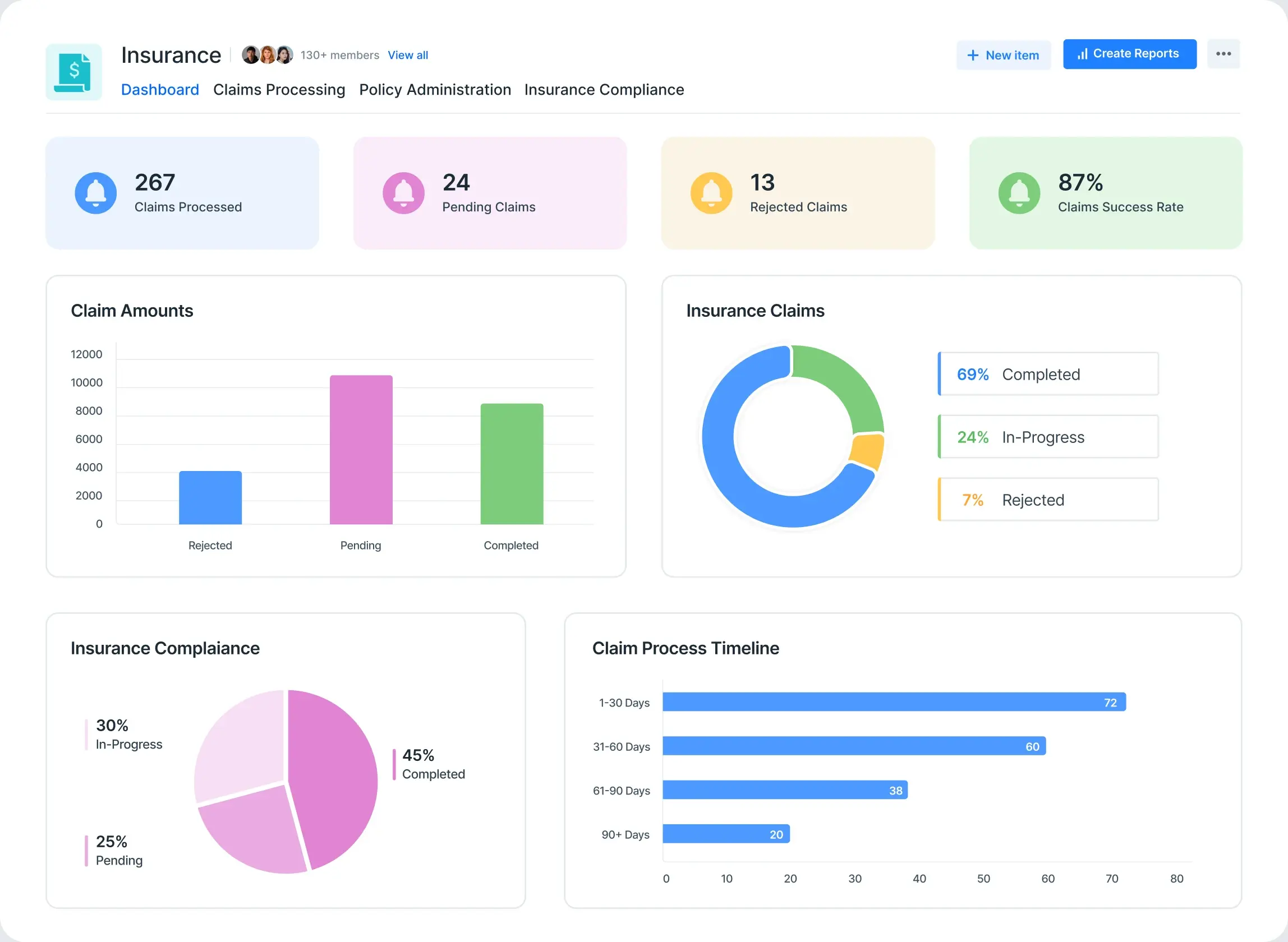
Core features:
- Automated claim intake, approval routing, and document verification
- Enables seamless document management through customized flows
- Connectivity with existing core systems, CRM systems, and data sources via prebuilt connectors or APIs
- Workflow analytics, SLA tracking, and dashboards
Pricing:
Kissflow offers 2 plans, starting at $1,500 per month for the Basic plan (includes 50 business users), and custom pricing for enterprises. The product trial can be provided upon request.
9. Guidewire ClaimCenter
Guidewire ClaimCenter is a claims processing system specifically designed for property and casualty (P&C) insurers. As a part of the broader Guidewire InsuranceSuite, it offers robust automation capabilities to streamline the end-to-end claims lifecycle, from first notice of loss (FNOL) to resolution.
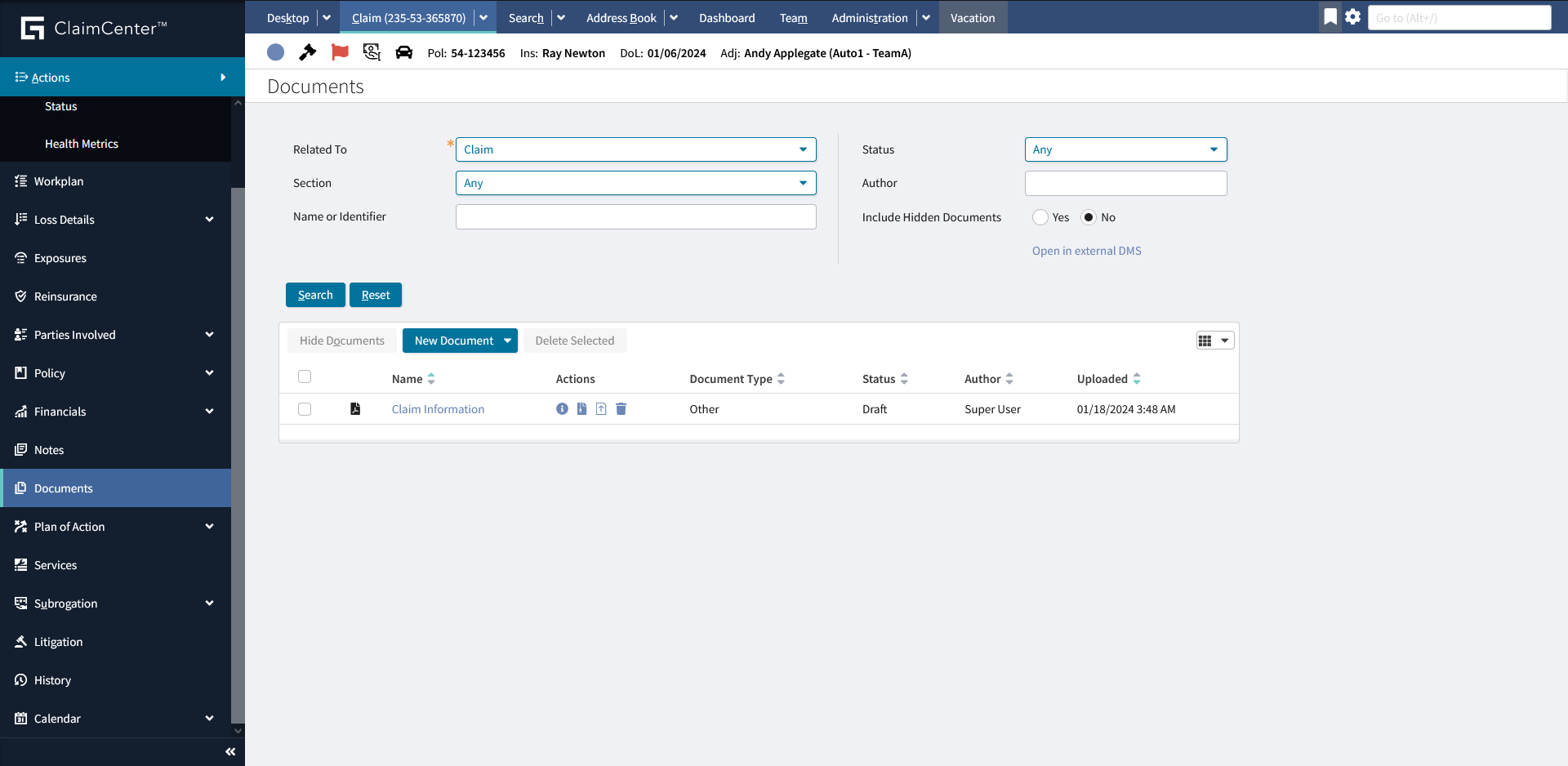
Core features:
- Centralized claim data, documents, communications, and status tracking in a unified system
- Regulatory compliance functionality, such as business rules, documentation standards, and reporting tools
- Guidewire Cloud – for faster implementation, scalability, and lower IT overhead
- Integration with policy systems, billing, fraud detection tools, and third-party data providers through Guidewire’s Marketplace
Pricing:
The platform’s pricing is provided upon request, product demo is available.
10. Britecore
BriteCore is a cloud-native platform for the insurance industry built specifically for property and casualty (P&C) insurers. It provides insurance leaders with end-to-end policy management, billing, and claims tracking, combined with built-in tools to automate complex workflows.

Core features:
- Automation solutions for the underwriting process, policy issuance, claims and other tasks
- Customizable rules engine for users without deep technical expertise
- Cloud-native architecture to enhance data security and scalability
- Dashboards and performance insights to optimize operations and improve service delivery
Pricing:
The platform’s pricing is provided upon request, product demo is available.
Key Benefits of Insurance Process Automation Systems
Beyond task management, integrating automated operations offers a wide range of benefits for insurance companies. Below, we’ve covered the five most impactful advantages of insurance workflow automation.
Improved Operational Efficiency
Traditional insurance processes often involve manual data entry, document routing, and multi-step approvals that create delays across the insurance lifecycle. These inefficiencies can slow down claim settlements, drive up operational costs and significantly increase workload.
Workflow automation standardizes and accelerates these steps by automatically routing tasks, validating inputs, and triggering next actions based on predefined logic. When powered with AI technologies, it eliminates the need for human intervention in routine tasks like handling document processing or submissions. What previously took days or weeks can now be executed faster and with fewer resources, driving efficiency across the board.
Enhanced Customer Experience
In a highly competitive insurance market, customers expect timely service, real-time updates, and self-service options. Manual processes rarely meet those expectations, especially during high-volume periods or claims surges.
By automating insurance workflows, companies can provide status notifications, self-service portals, and consistent communication throughout the customer journey. Moreover, insurance companies can also integrate AI agents to enhance specific workflows, such as claims triage, document analysis, and customer support, to further increase speed, accuracy, and personalization where it matters most.
Significant Cost Reduction
Automating workflows reduces the overhead associated with manual labor, human error, and slow task transitions. Key cost-saving areas include:
- Lower administrative and processing costs
- Fewer human errors and less rework
- Optimized workforce allocation
- Reduced compliance-related penalties
- Improved scalability without added headcount
- More efficient internal and client communication
These gains become especially valuable as the business scales or when handling complex, multi-step operations.
Stronger Compliance and Risk Controls
To align with the industry regulations, companies need to maintain accurate documentation, consistent processes, and full auditability – none of which are easy to complete manually.
Workflow automation ensures rule-based consistency and enforces required process steps across teams. Updates to regulatory rules or internal controls can be applied system-wide, helping insurers stay aligned with shifting requirements. Modern systems can also leverage AI to further strengthen risk oversight, for instance, by flagging unusual activity (e.g., potential fraud) or missing documentation.
Enhanced Visibility and Decision Support
Automated workflows generate clean, structured data across every touchpoint. Insurers can monitor process performance, identify delays or inefficiencies, and make informed adjustments over time.
Advanced platforms often include dashboards and reporting tools to track SLAs, task ownership, or customer trends. Where relevant, AI-based analytics can also enhance this process by surfacing insights on process delays, risk exposures, or customer behavior patterns to guide strategic decisions.
Use Cases for Automation in Insurance
Insurance automation software has a wide range of use cases within the insurance sector. They drive efficiency in numerous ways. Let’s look at five dominant use cases that tell us about the tools’ transformative potential.
Claims Processing
For years, processing claims has been heavily affected by manual interventions and time-consuming evaluations. But with insurance automation software, this process is completely transformed.
The software collects data from various sources, evaluates the claim against policy terms, and automatically processes valid claims - all greatly accelerating the process while ensuring accuracy and consistency to reduce errors that could cause over or underpayment.
According to McKinsey, automating claims processing can reduce costs by 25–30% due to reduced manual tasks and enhanced associated operations such as investigation and settlement.
Underwriting
The power of automation in insurance underwriting is undeniable. By leveraging vast data reservoirs - from medical histories to financial records - the assessment and issuance process has been expedited, resulting in more reliable pricing decisions.
As of 2023, over 25% of insurance organizations have initiated workflow automation for underwriting, according to Statista.
Billing Automation
Insurance billing involves periodic payments, multiple payment plans, and methods; automation can help streamline the process. Once you implement insurance automation software, you can schedule bills, process payments, and even manage late fees or penalties without manual involvement.
As a result, collections become more timely, and billing discrepancies are reduced.
Customer Support
Have customers ever been frustrated by limited office hours? With automation technology, insurance providers can now offer 24/7 customer support.
Chatbots and automated response systems quickly resolve common inquiries, so human agents are free to focus on more complex cases - ultimately delivering a superior service experience.
Marketing and Sales
Insurance agents face one of the most competitive markets out there. To succeed, they must accurately target their audience and convert leads into sales.
Automation software can make this process much easier by segmenting the market, automating lead generation processes, and customizing campaigns based on user behavior and preferences.
What’s more, your agents can track campaign success, compare performance, and gain actionable insights to better customize future strategies.
Case Study: Heritage Life Accelerates Operational Efficiency with Creatio
Heritage Life Insurance Company, a rapidly growing licensed provider operating in over 49 states, needed a scalable, flexible solution to unify its operations across departments, streamline internal workflows, and improve responsiveness in customer service.
By integrating Creatio’s no-code platform, the company was able to modernize its legacy systems and significantly enhance operational performance.
The key outcomes include:
- Unified customer data and workflows
Centralized all policy, claims, and communication records into one system, providing real-time access and visibility across teams. - Accelerated claims processing
Eliminated repetitive tasks using automated workflows, significantly reducing the processing times. - Improved first-contact resolution
Empowered service teams with accurate, real-time insurance data at every touchpoint, decreasing the volume of repeat inquiries. - Lower operational costs
Automated routine tasks and boosted employee productivity, helping the organization scale without increasing overhead.
In a recent video interview, the AVP of Operations at Heritage Life shared how the company successfully navigated its digital transformation using Creatio’s platform.
How to Implement Insurance Automation Software: 5 Steps to Consider
Successfully integrating insurance automation software into your company's operations requires a methodical approach. Here's a step-by-step guide to ensuring a seamless implementation:
- Step 1: Assess Your Business Needs.
Identify the specific pain points in your insurance workflows, such as slow claims processing, poor visibility of customer data, customer service inefficiencies, or similar. Define clear business goals and success metrics to guide your vendor selection and platform configuration. - Step 2: Evaluate and Select the Right Vendor
Compare automation platforms based on the key criteria like features, scalability, integration capabilities, security, and support. Review case studies, customer feedback, and total cost of ownership to ensure alignment with your business priorities. - Step 3: Customize the Solution
Tailor the insurance system according to your company’s unique workflows and compliance requirements. This may include custom rule sets, process adjustments, or integrations with existing systems like your policy administration, CRM, billing platforms, and other tools. Step 4: Plan and Execute Data Migration
Ensure all customer, policy, and claims data is securely and accurately migrated to the new system. Use validation steps and parallel testing to confirm data integrity and avoid disruptions during the transition.
Step 5: Train Your Teams
Provide employees with instructions on how to use the new insurance system effectively. This typically includes role-based training, user guides, and hands-on support to ensure efficient adoption and long-term success.
Enhance Your Insurance Operations with a Powerful Automation Platform
Insurance workflow automation has become a critical solution for companies aiming to streamline operations, reduce manual workload and achieve greater efficiency. Once implemented, it delivers immediate results across the key insurance processes, such as claims processing, customer onboarding, underwriting, policy administration, and compliance management, and many more. As a result, it allows insurance companies to accelerate performance and respond more proactively to market and regulatory changes.
Creatio offers an AI-native, no-code platform to automate complex processes and customer-facing operations across the insurance industry. Powered with predictive, generative, and agentic AI capabilities, Creatio enables insurance companies to stay ahead of industry shifts, rapidly deploy innovation, and deliver exceptional value throughout the customer lifecycle.





















































